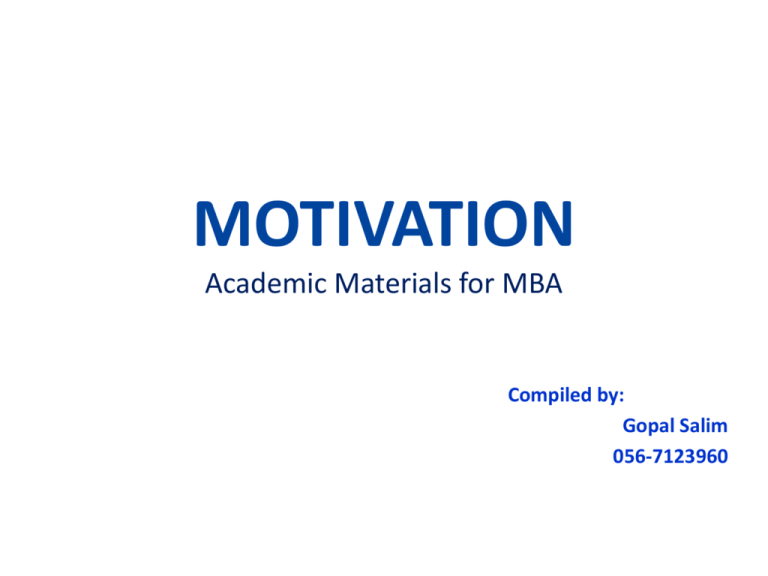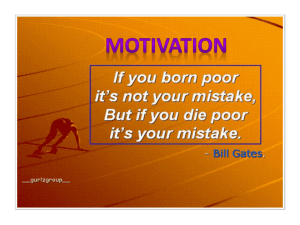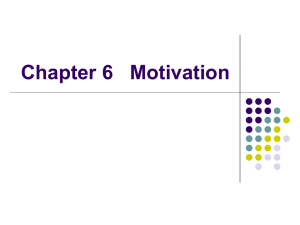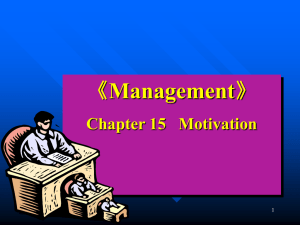motivation - managementforu.com
advertisement

MOTIVATION Academic Materials for MBA Compiled by: Gopal Salim 056-7123960 Starbucks Corporation Founded Founder(s) Headquarters Number of locations Area served Key people Pike Place Market in Seattle, Washington (March 30, 1971 (1971-0330)) Jerry Baldwin Gordon Bowker Zev Siegl Seattle, Washington, U.S. 17,009 (FY 2010) 50 countries Howard Schultz (Chairman, President and CEO) Motivation - Meaning • The word ‘Motivation’ is derived from the Latin Term ‘Movere’ which means ‘Move’. • Motivation is “the processes that account for an individual’s INTENSITY, DIRECTION and PERSISTENCE of effort towards attaining a goal” ( Stephen P. Robbins) • Motivation means to move. It includes three common characteristics: 1. It concerns with what activates human behavior 2. It involves what directs this behavior towards a particular goal. 3. Motivation concerns how this behavior is sustained or supported. INTENSITY How hard a person tries. DIRECTION Orientation towards goals PERSISTENCE How long can maintain effort • Motivation has got three common characteristics: 1. It concerns with what activates human behavior 2. It involves what directs this behavior towards a particular goal 3. Motivation concerns how this behavior is sustained (supported) Motivation Process Need Drive/Goal Directed Behavior Goal Incentive/Relief BASIC CHARACTERISTICS OF WORK MOTIVATION • • • • • • • • Direction of behavior & is psychological Level of effort Level of persistence Intrinsic and extrinsic motivation Dynamic and situational Not easily observed phenomenon Motivation is goal oriented process Motivation is influenced by social and cultural norms THEORIES OF MOTIVATION • Theories categorized into two groups. • CONTENT THEORIES – – – – – McGregor’s Theory X and Theory Y Maslow’s Hierarchy of Needs Theory ERG Theory Two Factor Theory McClelland’s Achievement Motivation Theory • PROCESS THEORIES – Expectancy Theory – Equity Theory – Porter & Lawler Theory MASLOW’S HIERARCHY OF NEEDS • People are not merely controlled by mechanical forces (stimuli and reinforcement) or unconscious instinctual impulses of psychoanalysis. SELF ACTUALIZATION ESTEEM LOVE, AFFECTION & BELONGINGNESS (SOCIAL) SAFETY NEEDS PHYSIOLOGICAL NEEDS HIGHER LEVEL NEEDS LOWER LEVEL NEEDS SELF ACTUALIZATION (Personal Growth, realization of potential) STATUS ( Titles, symbols, Promotion etc) SOCIAL NEEDS ( Formal or informal work Groups, Teams etc) SECURITY NEEDS ( Seniority plan, health insurance employee assistance plan, pension etc) BASIC NEEDS ( PAY ) ERG THEORY ( Alderfer 1972) GROWTH (Intrinsic Desire for Personal Development) RELATEDNESS (Interpersonal social relationship) EXISTENCE (Survival) 2.ERG THEORY &MASLOW’S THEORY GROWTH External Esteem & Self Actualization RELATEDNESS Social Needs & Esteem Needs EXISTENCE (Physiological Needs & Safety Needs) Difference Between ERG Theory and Maslow’s Theory • More than one need may be operative at the same time • If the gratification of a higher level need is stifled, the desire to satisfy a lower level need increases • ERG Theory does not assume that there exists a rigid hierarchy. A person can be working on growth even though existence or related needs are unsatisfied or all three need categories could be operating at the same time 3.HERZBERG’S TWO FACTOR THEORY • According to Herzberg , the factors leading to job satisfaction are separate and distinct from those that lead to job dissatisfaction. • He makes the following contention about satisfaction and dissatisfaction. Contrasting Views of Satisfaction and Dissatisfaction TRADITIONAL VIEW SATISFACTION DISSATISFACTION HERZBERG VIEW SATISFACTION NO SATISFACTION NO DISSATISFACTION DISSATISFACTION Contrasting Views of Satisfaction and Dissatisfaction DISSATISFACTION & DEMOTIVATION EMPLOYEE NOT DISSATISFIED, BUT NOT MOTIVATED POSITIVE SATISFACTION & MOTIVATION Major Components of Herzberg Two Factor Theory EXTRINSIC/HYGIENE FACTORS Company Policy & Admn. Relationship with supervisor Working conditions Personal Life Status Security Supervision etc INTRINSIC/MOTIVATORS FACTORS Achievement Recognition Work itself Responsibility Advancement Growth • Motivators are associated with long term positive effects in job performance • Hygiene factors consistently produced only short term changes in job attitude and performance • Satisfiers describe a person’s relationship with what he or she does and it relates to the tasks being performed • Dissatisfiers have to do with a person’s relationship to the context or environment in which he or she performs the job 3. McClelland's Theory Of Needs McClelland's theory is based on TAT McClelland identified three themes on such TAT stories, with each corresponding to an underlying need that he believes is important for understanding individual behavior. These needs include: Need for Achievement (nAch) Need for Power (nPow) Need for Affiliation (nAff) nAch (High n Achievers) • nAch • Derive satisfaction from reaching goals • Feeling of successful task accomplishment • Immediate feedback on performance • Moderate risk takers • Work independently High n Achievers • Joint Walt Disney in 1996 • Made turnaround for Disney’s ABC Family channel • Became President of ABC Television in 2004 High n Achievers • Indra Krishnamurthy Nooyi • CEO of Pepsi nPow (High n Powerful) • nPow • Derives satisfaction from his or her ability to control others • Actual achievement of goal is not very important but the means are of primary importance • Derive satisfaction from being in positions of influence and control nPow (High n Powerful) nAff (High n Affiliated) • nAff • Satisfaction from social and interpersonal activities • Strong interpersonal ties and to get close to people psychologically nAff (High n Affiliated) Muhammad Yunus : Micro Banking : Bangladesh Nelson Mandela : South Africa Assumptions of the theory • Individuals with a high need to achieve prefer job situations with personal responsibility, feedback, moderate risk • A high need to achieve does not necessarily leads to being a good manager, especially in large organizations as they are more interested in how well they do personally • The needs for affiliation and power tend to be closely related to managerial success. The best managers are high in their need for power and low in their need for affiliation 4. Goal Setting Theory (Locke & Latham 1990) • Challenging goals produce a higher level of output than do the generalized goals • More difficult the goal, the higher the level of performance • People do well when they get feedback • Goal serves as a motivator, because it causes people to compare their present capacity to perform with that required to succeed at the goal Goal Setting Theory • There are four contingencies in goal setting theory: 1. Goal Commitment 2. Adequate self-efficacy 3. Task characteristics 4. National culture ( North American) 5. EQUITY THEORY (Adams) • Employees make comparisons of their job inputs and outcomes relative to those of others • If an individual feels that his input-output is equal to that of others, a state of equity exists • He will perceive the situation as fair • If ratio is unequal, the individual experience inequity Referent comparisons used by employees • SELF-INSIDE • An employee’s experiences in a different position inside his or her current organization • SELF-OUTSIDE • An employee’s experiences in a situation or position outside his or her current organization • OTHER-INSIDE • Another individual or group of individuals inside the employee’s organization • OTHER-OUTSIDE • Another individual or group of individuals outside the employee’s organization Crucial Issues in Equity Theory • Employees with short tenure in their current organizations tend to have little information about others • Employees with long tenure rely more heavily on co-workers for comparison • Upper level employees will make more otheroutside comparisons Choice in Inequity • • • • • • Change their inputs Change their outcomes Distort perceptions of self Distort perceptions of others Choose a different referent Leave the field Organizational Justice 1. DISTRIBUTIVE JUSTICE • The perceived fairness of the way rewards are distributed among people 2. PROCEDURAL JUSTICE • Perceptions of the fairness of the procedures used to determine outcomes 3. INTERACTIONAL JUSTICE • The perceived fairness of the interpersonal treatment used to determine organizational outcomes 6. EXPECTANCY THEORY – Victor H. Vroom VALENCY X EXPECTANCY MOTIVATION ACTION GOAL ACHIEVEMENT SATISFACTION Determinants of Motivation • EXPECTANCY • The belief that one’s efforts will positively influence one’s performance • INSTRUMENTALITY • An individual’s beliefs regarding the likelihood of being rewarded in accord with his or her own level of performance • VALENCE • The value a person places on the rewards he or she expects to receive from an organization • OTHER DETERMINANTS • Skills, abilities, role perceptions, opportunity to perform etc INSTRUMENTALLITIES SECOND LEVEL OUTCOME EXPECTANCY FIRST LEVEL OUTCOME OUTCOME 1A OUTCOME 1 OUTCOME 1B MOTIVATIONAL FORCE OUTCOME 2 OUTCOME 2A OUTCOME 2B OUTCOME 2C Key Relationships in Expectancy Theory Individual Effort Individual Performance Organizational Rewards Personal Goals Three Key Relationships • EFFORT – PERFORMANCE RELATIONSHIP • PERFORMANCE – REWARD RELATIONSHIP • REWARDS – PERSONAL GOALS RELATIONSHIP PERFORMANCE FORMULA • Performance of an employee is based on ABILITY, OPPORTUNITY AND MOTIVATION • Therefore PERFORMANCE = f ( A X M X O ) Where A is ability M is motivation O is opportunity PERFORMANCE IMPACT Application of Motivation Theories 1. Goal Setting Goal setting is used to motivate staff in organization The use of goal to motivate task accomplishment draws on two primary attributes: (i) The Content of Goal and (ii) Level of Intensity in Working Towards it. Application of Motivation Theories (i) Current Level of Difficulty Goal should be challenging enough to induce high levels of effort So the managers should take this factor into consideration while setting goals to the employees. (ii) Level of Intensity in Working Towards Goal There can be three ways in which goals can be set. They are: a. When goals are assigned by the management b. Where members are asked to participate in goal setting c. When members are told to do their best Studies prove that the first two methods are more effective in motivating the people to achieve their targets and goals. Goals IMPORTANCE OF GOALS Goals guide and direct behavior Goals serve as an organizing function Goals provide benchmarks Goals may define the basis for organizational design. LIMITATIONS OF GOAL SETTING If employees lack skill and ability, they may not be able to achieve the goals When the employees are given complicated task, goal setting fails Goals REACTION OF DISSATISFIED EMPLOYEES 1. Job avoidance ( quitting) 2. Work avoidance (absenteeism, arriving late or leaving early) 3. Psychological defenses ( alcohol, drug abuse etc) 4. Constructive protest (complaining) 5. Defiance (Refusing to do what is asked) 6. Aggression (theft or assault) REWARD SYSTEM FOR HIGH PERFORMANCE a. b. c. d. e. f. Reinforcement or reward system is the process of managing behavior or reshape behaviors by having a contingent consequence follows behavior The ability of the reward to motivate individuals or a team of high performance depends on the following factors: Availability of rewards Timeliness of rewards Performance contingency: Linkage between performance and rewards Durability of rewards Equity in providing rewards Visibility of rewards





